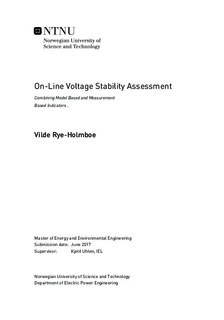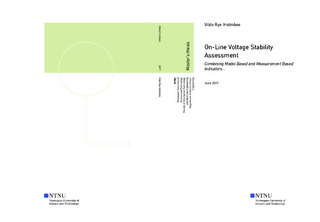| dc.description.abstract | This master thesis has examined the possibility of combining measurement and model based methods for on-line voltage stability assessment in the power system. Voltage instability may lead to voltage collapse and blackout of total or parts of the system. To avoid severe damage to equipment, disconnection of customers and the resulting economic costs it is significant to know how far the system is from the stability limit. It is desirable that the system operator is warned as soon as possible when the system approaches the stability limit so that he/she has time to initiate countermeasures.
The maximum loadability of the transmission grid has been found to be a good indicator of voltage stability. A proposed method combining Continuation Power Flow (CPF) and the S-Z Sensitivity Indicator (S-ZI) has been presented and implemented in a case study where a power system approaches voltage collapse, through a series of consecutive disturbances. The CPF is based on a system model and requires measurements from the whole system (provided by the State Estimator (SE)). It finds a continuum of power flow solutions at the load bus to find the maximal loadability, which makes it computational demanding to carry through. Since it uses a model of the whole system, it is possible to simulate potential outages in the system, to study the steady-state stability after contingencies. The S-ZI uses measurements from the Phasor Measurement Unit (PMU), placed at the load bus. The S-ZI needs few measurements, is easy to compute and can, therefore, be conducted more frequently than the CPF.
The master thesis proposes a new method that aims to combine the accuracy of the CPF, with the frequency of the S-ZI. By combining the resulting maximum loadability estimated by the S-ZI (computed every 40 ms), which is then corrected by the CPF (computed every 5 minutes), the proposed method finds a new maximum loadability of the system, P_(MAX,REAL).
The proposed method was able to detect that the system had moved into the alert state after the system had been subjected to a contingency. Based on the results of the case study, it is not, however, possible to conclude that the actual maximum loadability of the system have been found by the proposed method.
Both the S-ZI and the CPF were found to overestimate the maximum loadability of the system. Particularly the maximum loadability estimated by the S-ZI was found to vary a lot, overestimating the maximum loadability limit by as much as 2-3 times compared to the actual limit at some time steps. The variation in the resulting P_(MAX,S-ZI) is too big to give any real information about the change in the maximum loadability between every time the CPF is solved. The results of the case study show that the proposed method can, at best, provide an indication of where the system is headed. Further study is needed to find a more appropriate monitoring of the actual variation of the maximum loading limit in the system. | |

